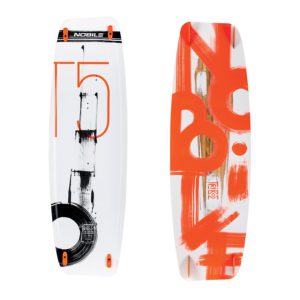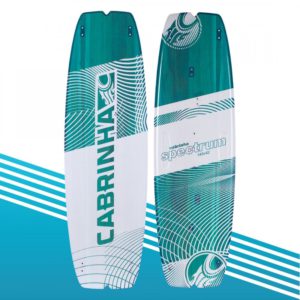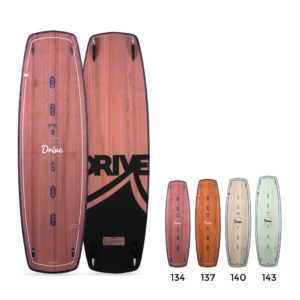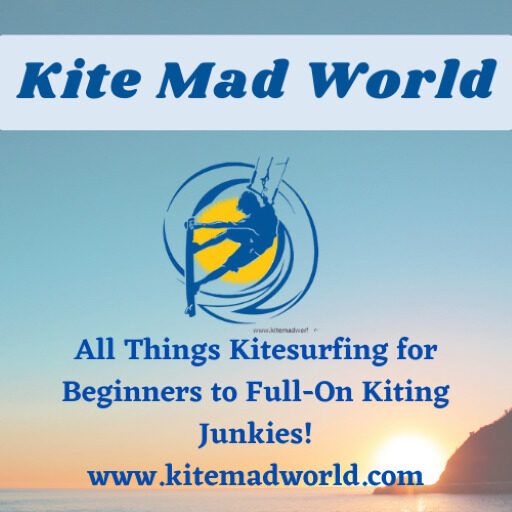In my article “Best Kiteboard for Beginners” I talk about the features you should be looking for in your first kiteboard and explain what effect the different design characteristics have.
The first thing to say about board choice is that virtually any twin-tip is usable, even as a beginner, but there are some features that will make your early days easier.
These are mainly:
Size – The right length and width (i.e surface area) will make it easier to get up and planing in the early days. Don’t go too big. It’ll help for the first few sessions but will limit your progression. But be realistic. My earlier article covers this in more detail.
Profile – Very square edges and tips make early planing and going in a straight line easier but will make the board more difficult to ride in chop and waves, and will make turns and transitions more difficult.
Rocker-line – A reasonable amount of rocker makes the board easier to ride in chop and waves but too much makes early planing more difficult, especially in light winds.
Flex – You want a reasonable amount of flex to make the board more comfortable to ride and land from your first attempts at jumps.
Foot-pads/straps – Should have a good amount of cushioning and be a snug fit to help keep the board attached to your feet. Don’t use boots on your first board, they make it difficult to manouever to the water and also prevent you ditching the board when you have a wipe-out.
When it comes to kite boards for beginners the main thing to look for in the description of a board’s style is “free-ride”. This means the board is an all-rounder, good for flat water, waves, chop, jumps, turns and most tricks.
Don’t confuse this with “free-style” which tends to mean the board is geared toward wake-style tricks and will be a bit too stiff for comfort in chop.
All the boards I’ve featured are great kite boards for beginners and have the right attributes to take you from beginner to advanced rider. As you progress and get a feel for the types of riding you prefer you may well buy other boards for different styles.
If there’s one item of your kit that you can afford to save money on it’s your first board. They’re hard-wearing and a few scrapes and scratches won’t affect the performance.
The main part that can fail is the footstraps. If they haven’t been rinsed regularly they can perish and give way when you’re out on the water.
If you want to buy second-hand, leave a bit of info in the comments box and I’ll help you find something suitable.
But great boards can be bought new at very reasonable prices, especially if a retailer is selling off last year’s model to make way for the next version.
I made the mistake of buying a massive light wind board as my first. Whilst it was easy to get up and moving on it, within a couple of sessions, especially in stronger winds, it was too big to control.
The next board I bought, a Nobile T5 (or rather the second one – the first disappeared out to sea off Cape Verde – another story) still comes with me every time I go to the beach. I don’t always use it but only because I’m playing with a new board with more advanced characteristics. But I definitely haven’t outgrown it.
The boards I’ve featured will all give you the same years of use as I’ve had from my T5’s.
Here I’ve chosen 5 boards that I know will take you from your first tentative steps to a fairly advanced level.
I’ve also provided links to eBay pages where these boards can be bought new as I’ve found that eBay has the best selection at the best prices. Have a browse to get an idea of the prices.
Nobile T5
I have to be honest, I love this board, but that’s because it’s seen me from my very early stages right through to where I am 18 years later, and is a great all-round board.
The main features are:
Dynamic flex – the board is designed stiffer at the centre with progressively more flex towards the tips.
This makes early planing easy but means the board is very comfortable in chop and waves. The flex at the tips makes it very forgiving in hard landings from jumps.
It also gives it great”pop” – a term you’ll soon understand when you start to get airborne!
Light weight – It is light and feels it. This makes it easier to plane in light winds and has the effect of making you feel connected with the water surface. It also helps with big air jumps.
Wavy bottom channels – Very subtle concave channels on the bottom surface keep the board going in the direction you want and make up-wind travel a lot easier.
Asymmetric profile – The back “heelside” edge is longer than the front “toeside” edge. The longer heelside makes planing quicker and helps with upwind riding. The shorter toeside edge makes turns and toeside riding a dream.
T5 Wmn (Woman) version – It comes in a women’s version with smaller footpads/straps, more closely spaced and a slightly different profile, more suited to women/girls.
>>>>>>HERE’S SOME GREAT DEALS ON EBAY<<<<<<
Crazyfly Allround
A great board that lives up to its name. And new prices are very competitive too.
The main features are:
Soft flex – The board has dynamic flex, which makes it comfortable to ride and jump and gives it a reasonable amount of “pop”.
Single concave channel – From 2017 models onwards the formerly flat bottom was re-designed with a single concave channel. This helps with direction and upwind performance.
Upgraded footpads from 2017 onwards – The new footpads have nice heel indents and a small toe ridge that makes it comfortable and snug-fitting.
>>>>>>GRAB A GREAT DEAL RIGHT HERE<<<<<<
Cabrinha Spectrum
A great all-rounder with much of the basic DNA of more expensive boards from the Cabrinha line-up, without the cost.
Great footpads/straps available in the H20 pads option that have a choice of base pads so you can choose softer or firmer feel.
A board that will see you from beginner to intermediate although the trade-off between flex and stiffness limits the “pop” very slightly in favour of ride comfort. Most beginners to intermediates wouldn’t notice this to be honest.
The main features are:
Soft flex – Provides great ride comfort and means it handles choppy conditions nicely. Makes landings very forgiving.
Single concave bottom – Keeps the board going in the direction you point it and tracks it upwind a treat. Compensates nicely for more rounded profile.
Rounded profile and corners – Makes turns, transitions and toeside riding quick and comfortable and also helps with riding through waves and chop.
H20 Footpads/straps – Offer great comfort and feel secure under-foot without having to be so tight that it’s difficult to get your feet out in a wipe-out.
>>PICK UP A GREAT DEAL ON NEW SPECTRUMS HERE<<
Liquid Force Drive
Designed specifically for kiters wanting to progress from beginner to intermediate level this board is a great combination of value for money and useability.
It has a good amount of flex, which makes riding in chop and small waves easy and also helps with learning to jump. The high degree of flex helps absorb the impact of heavy landings.
The main features are:
Soft flex – makes for comfortable, forgiving riding in chop and great for learning to jump.
Single concave bottom – keeps the board moving forward and tracking upwind.
Choice of footpads/straps – If you can, go for the Pro-pads. They have nice heel concaves and raise instep and toe ridge to help keep your feet firmly in place.
All the pads come in a choice of S/M or L/XL.
>>>>>>GRAB A GREAT DEAL RIGHT HERE<<<<<<
Duotone Gonzales
Duotone’s (formerly North) entry level board, aimed firmly at beginners aspiring to progress.
Great build quality and plenty of flex to make for comfortable riding in chop.
The Gonzales also incorporates an innovation pioneered by Duotone, torsional flex, which means the board can twist slightly along its length, a feature designed to keep just the right amount of edge in contact with the water, which is great for early planing and upwind riding.
Main features:
Soft-flex – Makes the board comfortable to ride in chop. Also has more flex at the tips to help with riding into chop and waves and to absorb impact on landing from jumps.
Single concave bottom – Keeps the board tracking in the right direction and helps with upwind performance.
Rounded profile – To help with turns and transitions. This also helps with riding in waves and chop.
>>>>>>CHECK OUT THESE GREAT DEALS<<<<<<
Contact us for Advice
As I’ve mentioned, all of these boards have been chosen for their great all-round performance and forgiving ride characteristics. You won’t be disappointed with any of them. There are of course many similarly suitable boards available from most manufacturers, but look out for boards that have similar features to these ones.
A lot of the process of choosing the right board for you comes down to how much experience you’ve had when you buy and also the direction you expect to take your future kiting, whether you’ll be boosting large (that’s big jumps), free-riding or just getting out in whatever conditions you find.
And if you need advice on kites check out my article Kitesurfing Kites for Beginners.
So please leave a question below and I’ll happily point you toward the right board for you.
Affiliate disclosure: As an Amazon Associate I earn from qualifying purchases, and, as the owner of this website I may also receive a small commission for any purchase you make as the result of clicking a link



Nice article about kiteboards for beginners, these really make me smile! I have been trying it a couple of times with my YouTuber friend who makes videos about that stuff. It’s a little bit ridiculous regarding the “summer” time of Finland but it’s funny anyway. I have been considering to order some sort of kiteboard, some beginner stuff. Crazyfly Allround could be my pick, I will take a further look at it and think about buying. Shipping fees are usually pretty high but “thanks” to Scandinavian wellware governments, our nations taxes us like a devil. Thanks to these taxes, if you buy something between $500 and $700, after taxes its slightly under $1000. So even after shipping fees of $200 ordering these from places that doesn’t hate working and companies, its cheaper than buying it here. However, thanks for sharing this!
Hi Jesse, thanks for your comment. And I sympathise with you regarding the Finnish “summer”. Being based in North West England isn’t much better!
Maybe the answer on taxes is to go on holiday and come back with a board!?
The Crazyfly Allround is a great board and really good value for money. If you’re buying on Ebay it’s always worth checking the country the seller is based in. I’ve noticed that shipping fees from the US to the UK amount to up to $300 but a lot of the sellers are based in Europe and some offer free shipping.
If you need any help sourcing kit let me know, either here or email me at adrian@kitemadworld.com
I hope you carry on braving the Finnish weather and take up the sport fully.
Many thanks
Adrian.
Hello Adrian,
This is a very informative article about kiteboards. I really am a beginner at kiteboarding. Both my knowledge and experience are next to nothing regarding this action sport. I saw that you have given detailed information about few different kiteboards. I truly learned a lot about what to look for when buying kiteboards. Thank you for this interesting article. 🙂
Hi Anjali, thanks for taking the time to comment on my article. Your knowledge will grow quickly as you get going in this great sport. A great way to learn is to take a kite surfing vacation. I’ve written another article on kiteboarding destinations if you want to check it out.
If you need any help choosing equipment or if you need advice on any other aspect of the sport, feel free to contact me either here or at adrian@kitemadworld.com
Hi, been looking into one of these boards for my son over the last few weeks, and the sheer choice and variety make it very hard to come to a decision – we are obviously looking for a starter model if possible.
When you state that the boards you’ve covered have ‘forgiving ride characteristics’, what do you mean by this?
Do you mean that they are suitable, and easy enough for newcomers to invest in?
Hi Chris,
Thanks for visiting my site.
By “forgiving” I mean that a board with a reasonable amount of flex will absorb a lot of the bouncing about that you can experience when riding over choppy water or in waves. A stiffer board will transfer a lot of this to the rider’s legs, which can become uncomfortable. Also, when your son progresses to learning his first jumps (which is usually the first trick new kiters want to master), the flex in the board absorbs a lot of the impact from hard landings.
Any of the boards I’ve featured will be suitable once he’s had a few lessons and managed to get up and moving on a board, and as an investment they’ll last him for a good few years.
It’s important to get an appropriate size, which will be based mainly on his weight. If you want to let me know whether he’s had lessons and what size and weight he is I can suggest a size range. feel free to post the info here or email me at adrian@kitemadworld.com
I noticed the great suggestions on boards, but nothing about fins. In lessons I learned with 4 fins (2in each end). But when I received my twin fin beginner board, it only came with two fins and I don’t know what to do with them now. 🙁
Hi Sara, thanks for visiting Kite Mad World.
Fins come as standard with a board.
If your board is a twin tip then it should have 4 fins. New boards usually arrive with the fins loose and they need to be screwed on with the screws that come with them. The vertical side of the fin faces toward the end of the board.
What type of board is it? Are there 2 holes at each corner?
I would check the packaging to be sure they aren’t in there somewhere. If they are missing then you should contact the seller.
You can order fins from the manufacturer usually, if they can’t be found.
Hey Adrian,
Really helpful article, thank you. I have been getting into kitesurfing recently (a few summers now) and am currently looking to upgrade some of my equipment. I kitesurf in quite choppy waters with a decently strong current and am finding riding upwide still a slight challenge. My current board is a 135 and is way too small & therefore, I’m looking at getting a replacement. I have recently come across a sale, which would allow me to purchase a Shinn ADHD 142×43 board for a relatively good price. However, I’ve been told (by a friend) that this board would be way too advanced for me. As it’s quite an investment would you have to agree?
I wouldn’t want to purchase a door as I’d like to progress on the board i’m able to purchase and I would like a rocker line of some sorts in order to get through all the chop from the waves.
Thanks in advance for your time and effort
Hi Laurens,
Thanks for checking out the article, and for your kind comments!
I would agree with your friend about the Shinn board. It’s Designed mainly for wakestyle and free-style and is very stiff. It also has a pronounced rocker-line which won’t help with your upwind riding at this stage.
What sort of weight are you (if that’s not too personal)? And what board is the 135 you’ve been using.
I’d tend to go for more of an intermediate board, like the Nobile T5 or Crazyfly Allround. I’ve found a couple of good deals on eBay but they’re for a 137 and 138 respectively. Here’s the link to the T5:
https://rover.ebay.com/rover/1/710-53481-19255-0/1?mpre=https%3A%2F%2Fwww.ebay.co.uk%2Fitm%2FKITEBOARD-NOBILE-T5-2016-NEW-137×42%2F351863313017%3F_trkparms%3Daid%253D111001%2526algo%253DREC.SEED%2526ao%253D1%2526asc%253D20160811114145%2526meid%253D2b4e417c4fb9420cb81a6d73e2695a33%2526pid%253D100667%2526rk%253D1%2526rkt%253D8%2526mehot%253Dnone%2526sd%253D351863313017%2526itm%253D351863313017%2526pmt%253D0%2526noa%253D1%2526pg%253D2334524%2526brand%253DNobile%26_trksid%3Dp2334524.c100667.m2042&campid=5338599212&toolid=10001&customid=
Whether these would be too small depends a lot on your weight, but the extra couple of inches length, combined with (probably)some extra width will make a lot of difference.They’re both great boards for your stage of progression and will last you a long time. They also cope really well in chop.
Let me know what you think and I’ll be happy to help some more.
Many thanks
Adrian
Dear Adrian, Thanks for the quick reply. I weigh roughly 75kg (165lb). I’m not actually sure what the model is (I can’t seem to find it online) it’s a small 135×40 board with curved edges (I am aware that this is not a suitable beginners board). Thank you for the board suggestions, I’ll keep my eyes peeled. However, this place is offering a few Shinn boards, as such would a Shinn Ronson 136×41 be a better board for me?
Hi Laurens,
Thanks for that info. At your weight you can get away with a smaller board as an intermediate. And Shinn make some of the best boards on the market. In fact Nobile is Shinn’s sister company so the boards have similar design characteristics (Nobile is the more mass-produced/cheaper range).
I have to admit I haven’t ridden the Ronson, but have checked out the specs and reviews and it should suit you pretty well, although still has quite a curved outline so will still take some practice to get upwind. The only slight concern I’d have is over the size. If you’re struggling on your 135, then going for a 136 might not make that much difference. They do a 138×42 that might suit you better.
The other thing to consider is whether it’s your technique that might need some simple changes. Often, if you’re struggling to get upwind a couple of tweaks in riding style can be all that’s needed. Try turning your head toward the upwind direction. At the same time, if you drop your front hand away from the bar it will turn your whole stance upwind. It might just be a question of getting enough board speed, which is where a slightly bigger board will help.
If you end up going for a 138 I would keep hold of the 135 though as you’ll enjoy it once you get more experience, especially in stronger winds.
I hope this helps, but feel free to get back to me with any other thoughts or questions.
Hi there
There is a dead helpful article so thank you for writing it…. but I’m still unsure what kit to buy?!! I’m at the stage of practicing consistency to do waterstarts, can go left but struggling on right. Im 60kg… I was riding a crazyfly for lessons in the Uk.. I’m on a budget but also would like to still keep it as I progress a little. I was advised to buy a good 9m for a kite. What would you recommend? Thank you?
Hi there
This is a dead helpful article so thank you for writing it…. but I’m still unsure what kit to buy?!! I’m at the stage of practicing consistency on waterstarts, can go left but struggling on right. Im 60kg… I was riding a crazyfly for lessons in the UK.. I’m on a budget but also would like to still keep it as I progress a little. I was advised to buy a good 9m for a kite. What would you recommend? Thank you?
Hi Philippa!
Thanks for checking out my article, and for your really kind comment.
And sorry about the delay coming back to you – no wind today, so I took the dogs on a big walk!
What sort of budget are you thinking of? Just so that I can advise on whether new or second-hand is what we’re looking at.
If you’re in the secondhand market I’m happy to have a look around and see what’s available.
Whereabouts in the UK are you based?
Hey Adrian,
thanks for the informative article. It’s very helpful! 🙂
I would love to buy a board for my boyfriend for Christmas, but unsure what would be the best board for him. He is a beginner, who made his first meters on the board, but still struggles with a water start.
There are some great deals for couple of boards and I am considering to buy one of them.
– Spleene Session 141×43
– Naish Haze 141×41
– Cabrinha Spectrum 2015 140×42
Which would you recommend and what is the difference between them?
Thank you! 🙂
Hi Elena,
Thanks for checking out my article, and I’m pleased you found it helpful.
And he’s a very lucky boyfriend!!
Just a couple of questions to help me advise you:
Where are you based?
Can you give me an idea of his weight?
Any idea what size board he’s been using to learn on (don’t worry if you don’t know)?
What sort of money are you thinking of spending?
Cheers
Adrian
Thanks for your quick reply. His weight is roundabout 80kg and
I guess he was practicing with a cabrinha 142 or 143cm.
We live in Germany, but love to travel a lot so that he’ll use this board at different locations. Our next stop will be Cape Town…
I was thinking about 200-300€ for a second hand board.
Hi Elena,
Thanks for that.
Personally I would go for the Cabrinha Spectrum. They would all work okay, but I think the Spectrum would take him from where he is now to more advanced stages. The Naish and Spleene boards are more designed as light wind boards, but the Spectrum is a good allrounder.
There’s a great deal on one here on ebay if that’s any help: Cabrinha Spectrum . But let me know what you think.
Thanks for the
advice!
I think the Cabrinha is the best
board in
the long run.
Thank you!
Hi Elena,
I think so. And that one I’ve given you the link to is brand new so a great deal, and from a reputable dealer I know well.
Feel free to contanct me if you or your BF need any more advice.
I know he’ll be VERY happy!